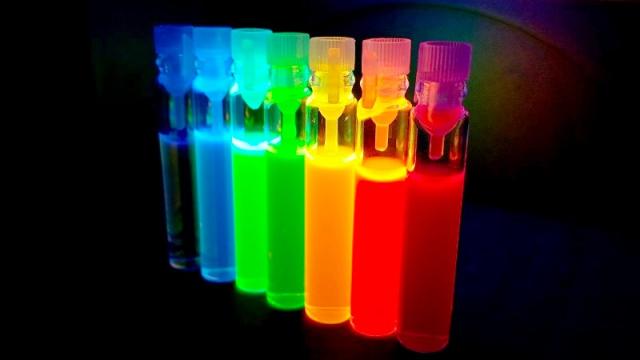Quantum dots have been a topic of conversation when it comes to improving the colour reproduction and energy efficiency of flat panel displays for decades now. In recent years we’ve finally started to see quantum dot TVs hitting the market, but researchers from Chung-Ang University in South Korea believe quantum dots could be just as beneficial for digital photography too.
As we explained back in January, “Quantum dots are very small semiconductor nano-crystals that glow a specific colour when activated by light, and the technology results in images that are brighter, more vivid, and more accurate and natural in terms of the colours they represent.” Recent innovations have seen quantum dots paired with OLED screen technology to create TVs capable of generating impressive brightness with vivid colours and deep blacks, all while being more energy-efficient. Quantum dot technology has certainly been heavily hyped by TV makers over the past few years, particularly at events like CES where TVs take centre stage, but it’s a technology that warrants the hype, especially as researchers are finding new innovative uses for it.
For years, megapixels have been a heavily marketed metric when it comes to the improved capabilities of a new digital camera hitting the market. Being able to capture more pixels means being able to capture more details, but there’s a limit to how densely a camera’s sensor can be packed with light-detecting pixels. For most consumers sharing their snaps on social media, the megapixel capabilities of modern smartphones and consumer-level digital cameras are more than adequate now, but there are other applications, such as the sensors and cameras used by autonomous vehicles to see the world around them, that can benefit from more and more pixels being packed into a sensor.
If you look at a typical CMOS sensor under a microscope, you’ll find a grid of photo-diodes covered by a colour filter that allows information about colour data to be captured. But each photo-diode can only capture information about a single colour (there are typically two for green next to one for red and one for blue) so four squares on the grid are needed to capture the full-colour information for just a single pixel in an image. If every square on that grid could instead capture red, green, and blue colour information at the same time, the density and resolution of a sensor would instantly quadruple, and that’s where quantum dots come into play.
In a recently published paper in the Advanced Materials journal, researchers from Chung-Ang University in Seoul, South Korea, have found that quantum dots with a very specific size and composition can be customised to only respond to light of a specific colour, allowing them to function similarly to the photo-diodes on an image sensor, but without the need for a colour filter. Furthermore, quantum dots tailored to respond to red, blue, and green light can actually be stacked atop each other and photons not absorbed by the upper layers simply pass through to the lower ones so the bottom-most layer still works just as effectively at detecting coloured light as the top one.
When arranged into a grid to create a sensor, every element is collecting information on every colour, and the size of quantum dots also allows an incredible number of pixels to be packed into a small area. The researchers created a photodetector array with 5,500 pixels packed into just a single square centimeter, which promises to not only catapult megapixel counts, but also allow companies to design cameras and sensors that are much smaller than what’s available today — all without sacrificing resolution or performance. So, while the completely autonomous vehicles being tested on roads around the country usually feature a roof rack full of sensors and cameras, as quantum dots come into play, all of that equipment could be miniaturized and easily integrated into a vehicle’s bodywork.
